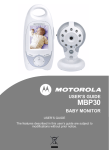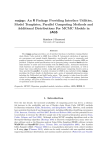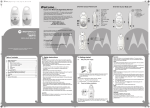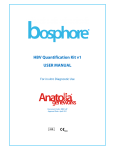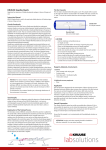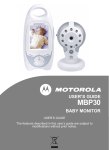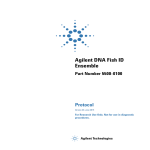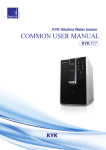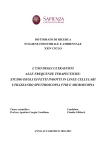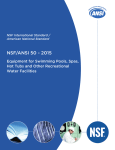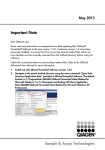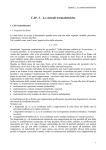Download PDF - 200.21 kbytes - Istituto Superiore di Sanità
Transcript
European Union Reference Laboratory for Parasites Department of Infectious, Parasitic and Immunomediated Diseases Unit of Gastroenteric and Tissue Parasitic Diseases Istituto Superiore di Sanità Identification of Giardia duodenalis cysts at the Assemblage level by PCR/RFLP INDEX 1. Aim and field of application 2 2. Principle of the method 2 3. References 2 4. Definitions 3 5. Devices/instruments 3 6. Reagents and chemicals 4 7. Procedure 7.1 Sample preparation 5 7.2 Method 5 8. Results 8 9. Characteristics of the method 8 10. Safety measures 8 page 1 of 14 European Union Reference Laboratory for Parasites Department of Infectious, Parasitic and Immunomediated Diseases Unit of Gastroenteric and Tissue Parasitic Diseases Istituto Superiore di Sanità 1. Aim and field of application To determine the identity of cysts of the protozoan Giardia duodenalis at the assemblage level by a PCR/RFLP analysis. This method can be applied to faecal material of human and animal origin already positive for the presence of Giardia cysts. 2. Principle of the method The PCR is a molecular biology technique that allows for the amplification of specific nucleic acid fragments, of which the initial and terminal nucleotide sequences are known (oligonucleotide pair). If a species (or genotype) has its own characteristic DNA portion, due to its composition and/or dimension, it is possible to choose an oligonucleotide pair allowing for its amplification. The PCR amplification is characterized by a high sensitivity and specificity. It is possible to combine the “standard PCR” with the “Restriction Lenght Fragment Polymorphism” (RLFP), that means the analysis of DNA restriction fragments. The technique allow to distinguish PCR fragments of comparable length by enzymatic digestion with one or more endonucleases, enzyme able to cut DNA by recognition of short and specific oligonucleotide sequences. In our case it is possible to amplify the same portion of DNA from different species and then distinguish them based on the size of restriction DNA fragments. The protozoan parasites of the genus Giardia infect the upper part of the small intestine of vertebrates, including humans. The parasite’s life cycle consists of a vegetative stage, the trophozoite, a teardrop-shaped binucleated cell, which divide by binary fission and colonizes the host intestine, and the tetranucleated cyst, the infective and resistant stage, which is able to survive outside of the host. Infection is acquired by cysts ingestion that undergoes excystation into trophozoites in the proximal small intestine after the exposure to the acidic environment of the stomach. Six species have been described based on the host specificity, the morphology and the phenotype: Giardia agilis in amphibians, G. muris and G. microti in rodents, G. ardeae and G. psittaci in birds, and G. duodenalis (syn. lamblia and intestinalis) in mammals. Giardia duodenalis is the causative agent of giardiasis, and it is the only species infecting both humans and other mammals, including livestock and companion animals. Seven morphologically indistinguishable Assemblages of Giardia duodenalis (referred to as Assemblages A to G) have been described, which can be identified based on genetic analysis. Only Assemblages A and B have been isolated from humans and a wide panel of mammals, whereas the other Assemblages (C-G) have host specificity and are not infectious for humans (Monis et al., 1999; Monis et al., 2003; Sulaiman et al., 2003). Molecular methods based on PCR/RFLP have allowed the identification at Assemblage level of G. duodenalis cysts present in human and animal faecal samples. Between these methods, the widely used is based on the 511 base pairs (bp) fragment of the beta-giardin gene (coding for a structural giardial protein) obtained by PCR amplification with two specific primers. The further digestion of the PCR fragment with the restriction endonuclease HaeIII allow the individual identification of each assemblage based on the pattern of digestion fragments size (Lalle et al., 2005). The size of the fragments produced by HaeIII digestion of the beta-giardin PCR fragment for each G. duodenalis Assemblage are shown in Table A. page 2 of 14 European Union Reference Laboratory for Parasites Department of Infectious, Parasitic and Immunomediated Diseases Unit of Gastroenteric and Tissue Parasitic Diseases Istituto Superiore di Sanità Table A - Size (in base pairs) of the beta-giardin fragments after HaeIII endonuclease digestion expected for each G. duodenalis Assemblage. Assemblage Digestion fragments A 201, 150, 110, 50 B C D E F G 150, 117, 110, 84, 26, 24 194, 150, 102, 50, 15 200, 194, 117 186, 150, 110, 26, 24, 15 186, 150, 110, 50, 15 194, 165, 102, 50 Using the PCR/RFLP technique, it is possible to distinguish between the G. duodenalis Assemblage A, B, C. D, E, F and G, based on the number and size of the digestion fragments with the HaeIII enzyme of the 511bp fragment of the beta-giardin gene. 3. References Adam RD. (2001) Biology of Giardia lamblia. Clin Microbiol Rev. 14, pp. 447-475. Amar CF, East CL, Grant KA, Gray J, Iturriza-Gomara M, Maclure EA, McLauchlin J. (2005) Detection of viral, bacterial, and parasitological RNA or DNA of nine intestinal pathogens in faecal samples archived as part of the English infectious intestinal disease study: assessment of the stability of target nucleic acid. Diagn Mol Pathol. 14, pp.90-96. Horiuchi K, Zinder ND. (1975) Site-specific cleavage of single-stranded DNA by a Hemophilus restriction endonuclease. Proc Natl Acad Sci U S A. 72, pp. 2555-2558. ISO/FDI 20837:2006(E). Microbiology of food and animal feeding stuffs – Polymerase chain reaction (PCR) for the detection of food-borne pathogens - Requirements for sample preparation for qualitative detection ISO/FDI 20838:2006(E). Microbiology of food and animal feeding stuffs – Polymerase chain reaction (PCR) for the detection of food-borne pathogens - Requirements for amplification and detection for qualitative methods Lalle M, Pozio E, Capelli G, Bruschi F, Crotti D, Cacciò SM. (2005) Genetic heterogeneity at the beta-giardin locus among human and animal isolates of Giardia duodenalis and identification of potentially zoonotic subgenotypes. Int J Parasitol. 35, pp. 207-213. Lebbad M, Mattsson JG, Christensson B, Ljungström B, Backhans A, Andersson JO, Svärd SG. (2010) From mouse to moose: multilocus genotyping of Giardia isolates from various animal species. Vet Parasitol. 168, pp. 231-239. Qiagen: QIAamp DNA Stool Handbook, Second edition July 2007. Monis, P.T., Andrews, R.H., Mayrhofer, G., Ey, P.L. (1999) Molecular systematics of the parasitic protozoan Giardia intestinalis. Mol Biol Evol. 16, pp. 1135-1144. Monis, P.T., Andrews, R.H., Mayrhofer, G., Ey, P.L. (2003) Genetic diversity within the morphological species Giardia intestinalis and its relationship to host origin. Infect Genet Evol. 3, pp. 29-38. Sato, S., Hutchison, C.A. III, Harris, J.I. (1977) A thermostable sequence-specific endonuclease from Thermus aquaticus. Proc. Natl. Acad. Sci. USA 74, pp. 542-546. Sulaiman, I.M., Fayer, R., Bern, C., Gilman, R.H., Trout, J.M., Schantz, P.M., Das, P., Lal, A.A., Xiao, L. (2003) Triosephosphate isomerase gene characterization and potential zoonotic transmission of Giardia duodenalis. Emerg Infect Dis. 9, pp. 1444-1452. Thompson RC, Hopkins RM, Homan WL. (2000) Nomenclature and genetic groupings of Giardia infecting mammals. Parasitol Today. 16, pp. 210-213. UNI EN ISO 22174: 2005. Microbiology of food and animal feeding stuffs. Polymerase chain reaction (PCR) for the detection of food-borne pathogens. General requirements and definitions page 3 of 14 European Union Reference Laboratory for Parasites Department of Infectious, Parasitic and Immunomediated Diseases Unit of Gastroenteric and Tissue Parasitic Diseases Istituto Superiore di Sanità 4. Definitions Beta-Giardin, coding sequence for a structural protein of the G. duodenalis cytoskeleton. Oligonucleotide, short sequence (15/30 nucleotide bases) used to amplify a specific DNA fragment SetA, mix of 2 oligonucleotide base pairs amplifying a 511 bp fragment of the beta-giardin gene from all G. duodenalis Assemblages. Reference faecal DNA, purified genomic DNA from faeces containing cysts of G. duodenalis Assemblage A. Positive control for the DNA extraction, aliquots of faeces containing cysts of G. duodenalis Assemblage A analysed in the same working session of test samples, to verify the efficacy of the DNA extraction session Reference trophozoite DNA, DNA extracted from in vitro coltured trophozoites of G. duodenalis WBC6 clone (Assemblage A). Used as spike in the control PCR reaction to assess the presence of PCR inhibitors in the faecal sample to be tested. Positive control for the amplification, purified genomic DNA from faeces containing cysts of G. duodenalis Assemblage A; this control is used in the amplification session to verify the efficacy of the PCR Negative control for the amplification, reagent grade water; this control is used in the amplification session to verify the efficacy of the PCR PCR, Polymerase Chain Reaction Restriction Enzyme. Restriction enzyme are enzyme of bacterial origin able to cut DNA at specific site, that are sequences of 4-8 base of length different for each enzyme, allowing the DNA fragmentation in a reproducible and specific manner. Endonucleases cut inside to the DNA chain. Enzyme concentration is measured as “enzymatic units” (U). In this case 1U correspond to the amount of enzyme needed to completely digest 1 µg of DNA. The definitions and terminology used in the UNI EN ISO 22174 standard are applied in the present protocol. 5. Devices/instruments 5.1 Bench top refrigerated centrifuge for 1.5 mL tubes, minimum 10,000xg 5.2 Freezer ≤-15°C 5.3 Thermomixer with vibration, temperature range 25÷100°C 5.4 PCR thermocycler 5.5 Refrigerator, temperature range +1 ÷ +8°C 5.6 Horizontal electrophoretic apparatus 5.7 Digital imaging system 5.8 Adjustable volume pipettes, volume range: 1-10µL, 2-20µL, 20-100µL, 50-200µL, 200-1000µL 5.9 Analytical grade water system production, resistivity ≥ 18 Mohm/cm 5.14 Vortex 5.10 Analytical balance, readability 0.1g 5.11 UV transilluminator 5.12 Orbital shaker 5.13 Qiaxcel, vertical capillary electrophoresis system page 4 of 14 European Union Reference Laboratory for Parasites Department of Infectious, Parasitic and Immunomediated Diseases Unit of Gastroenteric and Tissue Parasitic Diseases Istituto Superiore di Sanità 6. Reagents and chemicals 6.1 Lysis buffer. Commercial solution: QIAamp DNA Stool Handbook, QIAGEN, identified as “ASL” buffer. Store at room temperature. 6.2 InhibitEX Tablet. Commercial solution: QIAamp DNA Stool Handbook, QIAGEN, identified as “ASL” buffer. Store at room temperature. 6.3 Proteinase K. Commercial solution: QIAamp DNA Stool Handbook, QIAGEN, identified as “ASL” buffer. Store according to manufacturer’s instruction. 6.4 Tampone di lisi. Lysis buffer. Commercial solution: QIAamp DNA Stool Handbook, QIAGEN, identified as “AL” buffer. Store at room temperature. 6.5 Ethanol (96–100%). Commercial solution. 6.6 Binding Column. Commercial solution: QIAamp DNA Stool Handbook, QIAGEN, identified as QIAmp Mini Spin Columns. 6.7 Collection tube. Commercial solution: QIAamp DNA Stool Handbook, QIAGEN, identified as Collection tube (2 mL). 6.8 Washing buffers. Commercial solutions: QIAamp DNA Stool Handbook, QIAGEN, to be prepared according to manufacturer’s instruction and identified as ‘AW1’e’AW2’. Store at room temperature. 6.9 Eluting buffer. Commercial solution: QIAamp DNA Stool Handbook, QIAGEN, identified as “AE” buffer. Store at room temperature. 6.10 PCR master mix. 2x commercial solution, Promega, codes: M7501, M7502, M7505 (composition: dATP 400 µM, dCTP 400 µM, dGTP 400 µM, dTTP 400 µM, MgCl2 3mM, Taq DNA polymerase 50 U/mL), other commercial PCR master mixes should be considered suitable for PCR amplification. Store according to the manufacturer’s recommendations. 6.11 SetA. The oligonucleotide mixture (6.12) used for the PCR; the mixture is obtained combining an equal volume of the 2 oligonucleotides bGiarF and bGiarR (6.12). The final concentration corresponds to 20 pmol/µL; 100µL aliquots are prepared and stored frozen up to 24 months. 6.12 Oligonucleotides. Commercial preparation (Table B); the lyophilized products is reconstituted with TE 0.1x, according to the manufacturer’s recommendations, at a concentration of 100 pmol/µL; the lyophilized product can be stored frozen for up to 5 years; the reconstituted product can be stored frozen up to 18 months. Table B – Oligonucleotides present in the setA (6.11), their codes and amplified nucleotide sequences. Oligonucleotide sequence Code 5’-GAACGAACGAGATCGAGGTCCG-3’ bGiarF 5’-CTCGACGAGCTTCGTGTT-3’ bGiarR Amplified sequence Beta-giardina 6.13 Loading buffer 6x. Commercial product allowing DNA molecule electrophoresis to be performed. Store according to the manufacturer’s recommendations. 6.14 Agarose and high resolution agarose. Commercial products suitable for performing DNA molecule electrophoresis. The high resolution agarose is suitable for the analysis of small DNA fragments (25-700 bp), improving their separation in gel electrophoresis. Store at room temperature for up to 24 months. 6.15 TAE solution 50x. Commercial product (2M Tris-acetate, 50mM EDTA, pH 8.2–8.4 at 25°C). Store at room temperature for up to 24 months. 6.16 TAE solution 1x. 1000 mL preparation: take 20 mL of the 50x solution and bring to 1000 mL with water. Store at room temperature for up to 1 month. 6.17 Ethidium bromide solution. Commercial product 10 mg/L. For the working condition, dilute 1:100,000; for 100 mL solution, add 1.0 µL. Store in the dark at room temperature for up to 24 months. page 5 of 14 European Union Reference Laboratory for Parasites Department of Infectious, Parasitic and Immunomediated Diseases Unit of Gastroenteric and Tissue Parasitic Diseases Istituto Superiore di Sanità NOTE: Ethidium bromide is potentially mutagenous, carcinogenic and teratogenic; wear disposable gloves and handle the solution containing this substance very carefully. 6.18 L50. Commercial product containing markers for DNA molecular weight multiple of 50 bp. All commercial products containing molecules of multiples of 50 bp within the 50-500 bp range can be used. Store refrigerated according to manufacturer’s recommendations. 6.19 L100. Commercial product containing markers for DNA molecular weight multiple of 100 bp. All commercial products containing molecules of within the 100-1500 bp range can be used. Store refrigerated according to manufacturer’s recommendations. 6.20 Milli-Q grade water. Resistivity ≥ 18 Mohm/cm 6.21 Positive control for the DNA extraction, aliquots of faeces containing cysts of G. duodenalis Assemblage A analysed in the same working session of test samples, to verify the efficacy of the DNA extraction session. Store in refrigerator (5.5) for up to 2 years or frozen (5.2) for up to 5 years. 6.22 Reference faecal DNA, purified genomic DNA from faeces containing cysts of G. duodenalis Assemblage A. Store frozen for up to 10 years. 6.23 Restriction enzymes HaeIII. Commercial products suitable for DNA enzymatic digestion. Store refrigerated according to manufacturer’s recommendations. The oligonucleotide sequence recognized by each enzyme is reported in Table C. Table C - Oligonucleotide sequence recognized by HaeIII restriction enzyme. Restriction Enzyme Target sequence HaeIII 5’…GC CC…3’ 3’…CC▲GG…5’ ▼ 6.24 Restriction enzyme buffers. Commercial products suitable for DNA enzymatic digestion with defined pH and saline concentration. The buffers are commonly sell together with the corresponding restriction enzyme. Store refrigerated according to manufacturer’s recommendations. 6.25 Reference trophozoite DNA, DNA extracted from in vitro coltured trophozoites of G. duodenalis WBC6 clone (Assemblage A). Store frozen for up to 5 years. 6.26 QIAxcel kit: commercial products from Qiagen (code 929002 and 929004). Include separation cartridge and buffers for sample preparation and gel running. Store each component as indicated by the manufacturer. 6.27 Alignment marker: commercial products from Qiagen (code from 929520 to 929529). Store according to manufacturer’s instructions. 6.28 DNA size marker: commercial products from Qiagen (code from 929550 to 929558). Store according to manufacturer’s instructions. page 6 of 14 European Union Reference Laboratory for Parasites Department of Infectious, Parasitic and Immunomediated Diseases Unit of Gastroenteric and Tissue Parasitic Diseases Istituto Superiore di Sanità 7. Procedure 7.1 Sample preparation Test faecal samples, already checked for the presence of Giardia cysts, are inspected to verify the preservation conditions. Vials must be intact without any sign of material leakage. If the condition are not suitable the test is not performed. 7.2 Method 7.2.1 DNA extraction from faecal sample to be tested If not otherwise specified, the procedure is carried out at room temperature. Each working session requires that an aliquote of the positive control for the DNA extraction (6.21) will be submitted to the DNA extraction procedure and identified as “positive control for the extraction”. a) b) c) d) e) f) g) f1) Transfer 1 mL of each faecal sample containing 50% ethanol in 1,5 ml vials. Centrifuge (5.1) vials at 8.000 x g for 5 min. Discard the supernatant and add a volume of H2O equivalent to the starting volume of the sample. Centrifuge (5.1) vials at 8.000 x g for 5 min. Repeat washing as in ‘c’. Transfer 200 µL of faecal sample in 2 ml vials. Add 1.4 mL of ASL lysis buffer (6.1) and vortex to homogenate the sample. For the positive control for the DNA extraction (6.21) add the ASL lysis buffer (6.1) directly to the sample still frozen than vortex to to homogenate the sample. Incubate at 95°C in termomixer (5.3) and 1.400 rpm for 10 min. Centrifuge (5.1) vials at 12.000 x g for 1 min. Collect supernatant and transfer in new 2ml vials. Add one tablet of InhibitEX (6.2) and vortex for 1 min. Incubate for 1 min. Centrifuge (5.1) vials at 12.000 x g for 3 min. Add 25 µL of Proteinase K (6.3) in new 2 mL vial. Collect supernantant (m) and add to the 2 mL vial (j) Add 600 µL of lysis buffer AL (6.4) in the same vial. Incubate at 70°C in termomixer (5.3) for 10 min. Add 600 µL of ethanol (6.5) and vortex brefly. For each sample, put one binding column (6.6) in a collection tube (6.7). Transfer 600 µL of lysate (q) in a binding column (6.6) and centrifuge (5.1) at 12.000 x g for 1 min. Discard the collection tube (6.7) and transfer the binding column (6.6) in a new collection tube (6.7). Repeat from ‘s’ to ‘t’ for additional two times. Add 500 µL of wash buffer AW1 (6.8) to the binding column (6.6) and centrifuge (5.1) at 12.000 x g for 1 min. Discard the collection tube (6.7) and transfer the binding column (6.6) in a new collection tube (6.7). Add 500 µL of wash buffer AW2 (6.8) to the binding column (6.6) and centrifuge (5.1) at 12.000 x g for 3 min. Transfer the binding column (6.6) in a new 1.5 mL vial. Add 200 µL of elution buffer (6.9) to the binding column (6.6) and incubate for 1-2 min. Centrifuge (5.1) at 12.000 x g for 1 min., discard the binding column (6.6), store the 1,5mL vials with the eluted DNA. The obtained DNA will be defined ‘DNA/faecal sample’ and store frozen (5.2) for up to 5 years. 7.2.2 PCR amplification h) i) j) k) l) m) n) o) p) q) r) s) t) u) v) z) a1) b1) c1) d1) e1) Unless otherwise clearly stated, store tubes on ice; use tips with barrier and wear disposable gloves. At each working session, use a positive and a negative amplification control. Use reference faecal DNA (6.22) as positive control and water (6.20) as negative control. The following procedure use a 2x concentrated PCR master mix, in case of different concentration adjust the protocol according to supplier. a) Thaw DNA/faecal sample, 2x PCR MasterMix (6.10), SetA (6.11), and positive amplification controls, page 7 of 14 European Union Reference Laboratory for Parasites Department of Infectious, Parasitic and Immunomediated Diseases Unit of Gastroenteric and Tissue Parasitic Diseases Istituto Superiore di Sanità reference faecal DNA (6.22). Mark with a progressive number an adequate number of 0.2 µL PCR tubes. Prepare a adequate cumulative volume of the amplification mix. Evaluate the volume on the basis of a single sample amplification mix (Table D) and of the total number of samples plus two (1 for the positive amplification control and 1 for the negative one). b) c) Table D – single sample amplification mix: components and volumes d) e) f) g) h) 2x PCR MasterMix (6.6) 25 µL H2O 19 µL SetA (6.7) 1 µL Total 45 µL Mix the amplification mix by vortexing and centrifuge (5.1) at maximum speed for a few sec. Transfer 45 µL of the cumulative amplification mix to each PCR tube (point “b”). Add 5 µL of the DNA/faecal sample to be tested to each tube. Close the tubes, mix by vortexing (5.14) and centrifuge (5.1) at maximum speed for a few sec. Start the amplifying cycle (Table E) on the thermocycler device; wait for the temperature to reach 95°C and insert the tubes in the thermoblock by pausing the instrument. Table E – amplification cycles i) l) m) n) Pre-denaturation 2 min/95°C Amplification 30 s/95°C 30 s/55°C 60 s/72°C Number of cycles 35 Final extension 7 min/72°C At the end of the amplification phase, centrifuge (5.1) the tubes at maximum speed for a few sec. Add 5.0 µL of loading buffer 6x (6.13) if not present in the used PCR master mix. Vortex (5.14) and centrifuge (5.1) the tubes at maximum speed for a few sec. Keep tubes on ice or refrigerated (5.5) until starting electrophoresis. 7.2.3 Result display The analysis will be primarily conducted by capillary electrophoresis. In case of samples to be analysed are less than 8, or the capillary electrophoresis apparatus is out of order, the analysis can be done by conventional agarose gel electrophoresis. 7.2.3.1 Capillary electrophoresis a) Switch on the Qiaxcel instrument (5.14) and launch the software (BioCalculator) on the connected PC. b) Access to “Instrument control” panel by the menu “File”. c) Move the tube tray to the access position by selecting “Change Buffer” from the “Instrument control” panel. d) Check the presence of 12 tubes, containing at least 10 μL of the “Alignment Marker” (6.27), in the MARKER1 position of the buffers bowl. Then move the tube tray to the working position by selecting “Park” from the “Instrument control” panel”. e) Put the samples (minimum volume 10 μL) in rows of 12 starting from line “A”. If necessary, add an appropriate number of tubes containing QX DNA dilution buffer (minimum volume 10 μL) contained in the QIAxcel kit (6.26) to complete the row. f) For each round of analysis (including a maximun of 8 runs of 12 samples each), a tube containing DNA size marker (6.28) must be added. g) Set run parameters in the “Instrument control” panel as follow: “Method”= 0M500 page 8 of 14 European Union Reference Laboratory for Parasites Department of Infectious, Parasitic and Immunomediated Diseases Unit of Gastroenteric and Tissue Parasitic Diseases Istituto Superiore di Sanità “Sample”= sample code “Pos”= starting line “Time”= leave empty “Runs”= number of runs “User ID”= Mi-08 “Plate ID”= operator’s name h) i) j) k) Check off the 12 “Chan” boxes. Check off the “Automatically analyze after data acquisition” box. Push “Run” button to start the run. At the end of the run, close the software and switch off the instrument. 7.2.3.2 Allignment of the reference size marker The picks corresponding to the alignament markers (6.27) are identified by comparison of the electrograms of each sample with the electrogram of the negative control. Remove all the picks before and after the alignament markers, then reprocess data using the command “reprocess” from the “Analysis” menu or using the corresponding icon. The described procedure is standard for routine use. However for any further requirement the user must refer to the Qiaxcel user manual. 7.2.3.3 Agarose gel electrophoresis a) b) c) d) e) f) g) h) i) j) k) l) m) n) o) p) q) Assemble the electrophoresis apparatus (5.6) according to the manufacturer’s recommendations. For the gel preparation, use a comb suited for the number of samples. Add 2 gr agarose (5.11) in 100 mL TAE 1x (6.12) in a glass beaker. Gently resuspend the powder by rotation. Boil the agarose suspension for 30 sec. If the solution is not homogeneous, continue to boil for another 30 sec. Restore with water the volume lost by boiling. Allow the agarose solution to cool. Before it solidifies, add 1.0 µL of ethidium bromide solution (6.17). Shake gently to dissolve uniformly the ethidium bromide and pour the agarose in the gel tray previously prepared (a). Wait for the gel to solidify, which requires at least 30 min. Place the tray with the gel in the electrophoresis apparatus. Cover the gel with TAE 1x buffer (6.16) and gently pull out the comb. Load in each well 10 µL of the amplification product (point 7.2.2 “n”), respecting the progressive numbering of the tubes (point 7.2.2 “b”). The first and last wells are loaded with 15 µL of the L100 solution (6.19). Connect the electrophoresis apparatus with the power supply (5.6) and set 10 v/cm of gel. Run the gel for about 30 min or until the fastest dye, contained in the loading buffer, reaches a distance of 1 cm from the gel border. After 30 min, switch off the power supply, place the gel under UV illumination (5.12) and check the band separation. The electrophoresis run is adequate if it is possible to easily distinguish all bands of molecular weight marker ranging from 250 and 1500 bp. If the separation is incomplete, continue the run. At the end of the run, transfer the gel to the imaging system (5.7) and print the result. 7.2.4 Result Interpretation The amplification test is considered valid if: i) the amplification of the positive control shows an amplification product of 511bp; ii) the amplification of the negative control does not show any amplification product or, eventually, only bands related to unused oligonucleotides and/or primer dimer iii) the positive control of the extraction product shows an amplification product of 511bp. 7.2.4.1 Interpretation of the PCR amplification results on capillary electrophoresis The data analysis shall consider only those bands satisfying the following requirements: 1) Band size bigger than 50 bp; 2) Comprised between the two Alignment marker bands (6.27); page 9 of 14 European Union Reference Laboratory for Parasites Department of Infectious, Parasitic and Immunomediated Diseases Unit of Gastroenteric and Tissue Parasitic Diseases Istituto Superiore di Sanità 3) Intensity of the emission peak greater than a threshold value of 5%. In case of overlapped peaks, only the peak showing the higher intensity will be considered; if peak values are comparable, the result is rejected. The size of the amplification bands revealed by the electrophoresis is evaluated by: i) visual comparison with the “DNA size marker” (6.28) and with the positive extraction and amplification controls on the virtual gel; ii) comparison between the band size calculated by the software and the expected band size; 7.2.4.2 Interpretation of the PCR amplification results on agarose gel electrophoresis The size of the amplification bands (511bp) revealed by the electrophoresis is evaluated by their comparison with the reference molecular weight L100 (6.19) and with the positive control of extraction and amplification. The visual evaluation is considered sufficient and adequate In case the sample shows a not expected band, the sample will not further processed and the identification will not be possible. If the sample shows no amplification, reference trophozoite DNA (6.25) will be add to the DNA/faecal sample to be tested and amplified according to paragraph 7.2.5 in order to verify the presence of PCR inhibitors. If the fragment of 511bp will be amplified, the extraction of DNA will be done again starting from the faecal material to be tested. The species identification is made after enzymatic digestion of the amplified fragments comparing the size of the band(s) produced by the sample(s) with those shown in Table A. 7.2.5 Test for the presence of inhibitors by PCR If nor otherwise stated, keep tubes on ice or in a refrigerated box, use tips with barrier and wear disposable gloves. At each working session, use a positive and a negative amplification control. Use reference reference trophozoite DNA (6.25) as positive control and water (6.20) as negative control. The following procedure uses a PCR master mix at a 2X concentration. If the concentration is different, modify the procedure following the manufacturer’s recommendations. a) b) c) Thaw: DNA/faecal samples, 2x PCR MasterMix (6.10), SetO (6.11), amplification positive control (reference trophozoite DNA, 6.25). Mark with a progressive number an adequate number of 0.2 μL PCR tubes. Prepare an adequate cumulative volume of amplification mix. Calculate the volume on the basis of a single sample amplification mix (Table F) and of the total number of samples plus two (1 for the positive amplification control and 1 for the negative control). Table F– Amplification mix for a single sample: components and volumes d) e) f) g) h) 2x PCR MasterMix (6.10) 25 µL H2O 17 µL SetB (6.26) 1 µL Totale 43 µL Mix the amplification mix by vortexing and centrifuge (5.1) at maximum speed for a few seconds. Transfer 43 μL of the cumulative amplification mix to each PCR tube (point “b”). Add 2 μL of reference trophozoite DNA (6.25) and 5 μL of the DNA/faecal samples to be tested to each tube. Close the tubes, mix by vortexing and centrifuge (5.1) at maximum speed for a few seconds. Start the amplification cycle (Table G) on the thermocycler device (5.4); wait until the temperature reaches 95°C and insert the tubes in the thermoblock by pausing the instrument. Close the lid and restart the cycle. Table G – Amplification cycle Denaturazione iniziale 5 min/95°C Amplificazione 10 s/95°C page 10 of 14 European Union Reference Laboratory for Parasites Department of Infectious, Parasitic and Immunomediated Diseases Unit of Gastroenteric and Tissue Parasitic Diseases Istituto Superiore di Sanità Denaturazione iniziale 5 min/95°C 30 s/55°C 30 s/72°C Numero di cicli 35 Estensione finale 3 min/72°C i) j) At the end of the amplification step, centrifuge (5.1) the tubes at maximum speed for a few seconds. Leave the tubes on ice or in a refrigerator (5.5) before the electrophoresis. 7.2.6 Result display To visualize the results, follow the procedure described at point 7.2.3. 7.2.7 Interpretation of the PCR amplification results on agarose gel and capillary electrophoresis To interpret the results, follow the procedures described in 7.2.4 The amplification test is considered valid if: i. the positive control shows an amplification product of 511bp; ii. the amplification of the negative control does not show any amplification product or, eventually, only bands related to unused oligonucleotides and/or primer dimer. If the expected 511bp fragment will be amplified from the tested samples, the presence of inhibitors will be excluded and the sample will be considered as “negative”. On the contrary, a new DNA extraction from the test sample will be performed. 7.2.8 Enzymatic DNA digestion with endonuclease Unless otherwise clearly stated, store tubes on ice; use tips with barrier and wear disposable gloves. At each working session independent digestions with HaeIII enzyme are performed. The proper digestion will be checked by contemporary digestion of a positive control represented by the PCR amplification product of the reference faecal DNA. The procedure use a restriction enzyme at the initial concentration of 10-20 U/µl and 10x concentrated restriction enzyme buffers. In case of different concentration adjust the protocol according to the manufacturer’s instruction. a) Thaw PCR products, restriction enzymes and 10X restriction enzyme buffers. b) Mark with a progressive number an adequate number of 1,5 mL tubes. c) Prepare a adequate cumulative volume of the enzymatic digestion mix for each restriction enzyme. Evaluate the volume on the basis of a single sample enzymatic digestion mix (Table H) and of the total number of samples plus the positive control. Table H – Enzymatic digestion mix for a single sample: components and volumes d) e) f) g) h) i) l) m) n) 10x buffer (6.24) 2,0 µL Restriction enzyme (6.23) 5u (0,5 µL) PCR product 10 µL H2O 7,5 µL Total 20 µL Mix each enzymatic digetion mix by vortexing and centrifuge (5.1) at maximum speed for a few sec. Transfer 10µL of the cumulative amplification mix to each tube (point “c”). Add 10 µL of the PCR product to be tested to each tube. Close the tubes, mix by vortexing and centrifuge at maximum speed for a few sec. Incubate the tubes in thermomixer (5.3) at 37°C for 4h without shaking. At the end of the amplification phase, centrifuge (5.1) the tubes at maximum speed for a few sec. Add 4 µL of loading buffer 6x (6.13). Vortex and centrifuge (5.1) the tubes at maximum speed for a few sec. Keep tubes on ice or refrigerated (5.5) until starting electrophoresis. page 11 of 14 European Union Reference Laboratory for Parasites Department of Infectious, Parasitic and Immunomediated Diseases Unit of Gastroenteric and Tissue Parasitic Diseases Istituto Superiore di Sanità 7.2.9 Result display The analysis will be primarily conducted by capillary electrophoresis. In the case in which samples to be analysed are less the 8, or the capillary electrophoresis apparatus is out of order, the analysis can be done by conventional agarose gel electrophoresis. 7.2.9.1 Capillary electrophoresis a) b) c) d) e) f) g) Switch on the Qiaxcel instrument (5.14) and launch the software (BioCalculator) on the connected PC. Access to “Instrument control” panel by the menu “File”. Move the tube tray to the access position by selecting “Change Buffer” from the “Instrument control” panel. Check the presence of 12 tubes, containing at least 10 μL of the “Alignment Marker” (6.27), in the MARKER1 position of the buffers bowl. Then move the tube tray to the working position by selecting “Park” from the “Instrument control” panel”. Put the samples (minimum volume 10 μL) in rows of 12 starting from line “A”. If necessary, add an appropriate number of tubes containing QX DNA dilution buffer (minimum volume 10 μL) contained in the QIAxcel kit (6.26) to complete the row. For each round of analysis (including a maximun of 8 runs of 12 samples each), a tube containing DNA size marker (6.28) must be added. Set run parameters in the “Instrument control” panel as follow: “Method”= 0M500 “Sample”= sample code “Pos”= starting line “Time”= leave empty “Runs”= number of runs “User ID”= Mi-08 “Plate ID”= operator’s name h) i) j) k) Check off the 12 “Chan” boxes. Check off the “Automatically analyze after data acquisition” box. Push “Run” button to start the run. At the end of the run, close the software and switch off the instrument. 7.2.9.2 Allignment of the reference size marker The picks corresponding to the alignment markers (6.27) are identified by comparison of the electrograms of each sample with the electrogram of the negative control. Remove all the picks before and after the alignment markers, then reprocess data using the command “reprocess” from the “Analysis” menu or using the corresponding icon. The described procedure is standard for routine use. However for any further requirement the user must refer to the Qiaxcel user manual. 7.2.9.3 Agarose gel electrophoresis a) b) c) d) e) f) g) h) i) l) m) Assemble the electrophoresis apparatus (5.6) according to the manufacturer’s recommendations. For the gel preparation, use a comb suited for the number of samples. Add 3 gr of high resolution agarose (6.10) in 100 mL TAE 1x (6.16) in a glass beaker. Gently resuspend the powder by rotation and leave at 4°C in the refrigerator (5.5) for 30 min. Boil the agarose suspension for 30 sec. If the solution is not homogeneous, continue to boil for another 30 sec. Restore with water the volume lost by boiling. Allow the agarose solution to cool. Pour the agarose in the gel tray previously prepared (point “a”). Wait for the gel to solidify, which requires at least 30 min. Place the tray with the gel in the electrophoresis apparatus. Cover the gel with TAE 1x buffer (6.16) and gently pull out the comb. Load in each well the enzymatic digestion product (point 7.2.6 “n”), respecting the progressive page 12 of 14 European Union Reference Laboratory for Parasites Department of Infectious, Parasitic and Immunomediated Diseases Unit of Gastroenteric and Tissue Parasitic Diseases Istituto Superiore di Sanità n) o) p) q) r) s) t) numbering of the tubes (point 7.2.6 “b”). The first and last wells are loaded with 10 µL of the L50 solution (6.18). Connect the electrophoresis apparatus with the power supply and set 5 v/cm of gel. Run the gel for about 60 min or until the fastest dye, contained in the loading buffer (6.9), reaches a distance of 1 cm from the gel border. Stain the DNA by transferring the gel in 400 ml of ddH2O with 4 µL of ethidium bromide solution (6.13). Gently shake the gel on a orbital shaker (5.16). After 30 min, remove the staining solution and replace it with 400 ml of ddH2O. Gently shake the gel on a orbital shaker (5.16) for 15 min. Repeat the washing step. After 30 min, place the gel under UV illumination and check the band separation. The electrophoresis run is adequate if it is possible to easily distinguish all bands of molecular weight marker ranging from 25 and 1000 bp. If the separation is incomplete, continue the run. At the end of the run, transfer the gel to the imaging system and print the result. 7.2.10 Result Interpretation of the enzymatic digestion 7.2.10.1 Result Interpretation of the enzymatic digestion by capillary electrophoresis For the data analysis only the bands that satisfy the following characteristic will be considered: • band size greater then 15bp; • band comprise between the two bands of the alignment marker (6.27): • Intensity of the emission peak greater than a threshold value of 5%. In case of overlapped peaks, only the peak showing the higher intensity will be considered; if peak values are comparable, the result is rejected. In case of Assemblage B, it is acceptable that the 194 bp and 200 bp band are unresolved consequently appearing as a single band of higher intensity. 7.2.10.2 Result Interpretation of the enzymatic digestion by agarose gel electrophoresis The size of the amplification bands revealed by the electrophoresis is evaluated by: • visual comparison with the “DNA size marker” (6.28) and with the positive extraction and amplification controls on the virtual gel; • comparison between the band size calculated by the software and the expected band size; • In case the sample shows a not expected band, the sample will not processed further and the identification will not be possible. The enzymatic digestion test is considered valid if the digestion of the positive control shows a profile of bands product in accordance with Table A The species identification is made after enzymatic digestion of the amplified fragments comparing the size of the band(s) produced by the sample(s) with those shown in Table A. In case of Assemblage B, it is acceptable that the 194 bp and 200 bp band are unresolved consequently appearing as a single band of higher intensity. In case the sample shows a not expected band, the sample will not processed further and the identification will not be possible. page 13 of 14 European Union Reference Laboratory for Parasites Department of Infectious, Parasitic and Immunomediated Diseases Unit of Gastroenteric and Tissue Parasitic Diseases Istituto Superiore di Sanità 8. Results The results are expressed as follows: If the digestion profile with HaeIII is 201, 150, 110, 50 bp, the sample is identified as G. duodenalis assemblage A. If the digestion profile with HaeIII is 150, 117, 110, 84, 26, 24 bp, the sample is identified as G. duodenalis assemblage B. If the digestion profile with HaeIII is 194, 150, 102, 50, 15 bp, the sample is identified as G. duodenalis assemblage C. If the digestion profile with HaeIII is 200, 194, 117 bp, the sample is identified as G. duodenalis assemblage D. If the digestion profile with HaeIII is 186, 150, 110, 26, 24, 15 bp, the sample is identified as G. duodenalis assemblage E. If the digestion profile with HaeIII is 186, 150, 110, 50, 15 bp, the sample is identified as G. duodenalis assemblage F. If the digestion profile with HaeIII is 194, 165, 102, 50 bp, the sample is identified as G. duodenalis assemblage G. In case the digestion test was valid but the sample displays a profile of bands not comparable with those reported in Table A, identification at assemblage level will be considered “impossible”. 9. Characteristics of the method This method has been characterised in terms of repeatability and specificity. The results of the validation protocol are used to confirm that the method is suitable for the expected aim and are reported in the validation report, which can be received upon request. 10. Safety measures This method has to be carried out only by authorized personnel. The operator should wear individual protection devices during the test performance. For general safety measures, refer to the guidelines of CDC. page 14 of 14


















